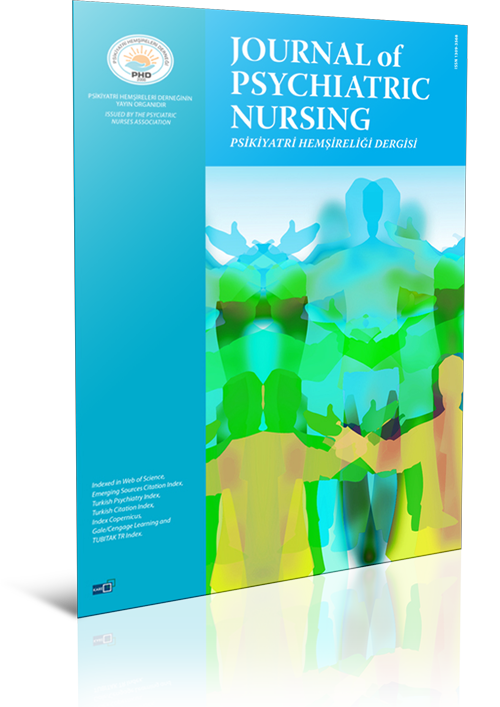
Volume: 6 Issue: 2 - 2015
| 1. | Frontmatter Pages I - III |
| RESEARCH ARTICLE | |
| 2. | Investigation of Effects of Exposure to Violence and Affecting Factors on Job Satisfaction of Emergency Nurses Arzu Bahar, Simge Şahin, Zehra Akkaya, Muhammed Alkayiş doi: 10.5505/phd.2015.18189 Pages 57 - 64 OBJECTIVE: This study aims to investigate the effects of exposure to violence and affecting factors on job satisfaction of emergency nurses METHODS: Research was conducted with 128 volunteer nurses who are currently working as emergency nurses at the emergency departments of six hospitals in Yenimahalle district of Ankara. Research was designed as a descriptive cross-sectional study and conducted between 15 January 2014 and 15 March 2014.Data was collected through Minnesota Job Satisfaction Scale and a questionnaire which elicits how nurses describe characteristics of job satisfaction and workplace violence. RESULTS: The average age of the nurses was 29.48 ± 6.47 years. It was found that 65.6% of the nurses were exposed to violence and 68% of the nurses were exposed to verbal abuse. Nurses job satisfaction scores were found to be moderate at 2.99 ± 0.59.There was a significant importance between exposure to violence and job satisfaction (p<0.05). Nurses that were exposed to violence in the workplace had lower job satisfaction scores compared to the nurses that werent. CONCLUSION: In our research it was found that exposure to work place violence was an adverse environmental factor that reduces job satisfaction. In this respect, since violence in the emergency departments is on the rise, preventing workplace violence will have a positive effect on job satisfaction of nurses. |
| 3. | Investigation of cancer patients information sources, information needs and expectations of health professionals Hatice Akgül Başkale, Pınar Serçekuş, Neslihan Partlak Günüşen doi: 10.5505/phd.2015.49091 Pages 65 - 70 OBJECTIVE: The aim of this study is to investigate cancer patients information sources, information needs and expectations from health care professionals. METHODS: This is a descriptive study. The most commonly used cancer blog users in Turkey participated in the study. The sample of study consisted of 120 cancer patients. Patients expectations from health care form, which was composed by investigators based on literature, was used for data collection instrument. RESULTS: While 82.5% of the participants obtained disease-related information from physicians, 70.8% obtained it from the internet. However, 97.5% of the patients wanted to get information from physicians, and 39.2% wanted to get information from nurses. Of the patients, 19.2% considered the medical staffs communication with patients as sufficient, 45.8% as partially sufficient, and 35.0% as insufficient. The patients expected physicians to provide information about the disease and treatment, to understand them to communicate with them better, to provide emotional support, to be helpful during the decision-making process about the disease and treatment, to respect them and to allocate more time to listen to them. The patients expected nurses to understand them, to respect them, to communicate with them better, and to provide better care and emotional support. The patients wanted the healthcare professionals to inform them about treatment and its side effects, the probability of recurrence of the disease, the effects of the disease on their psychological state, prognosis, duration of the treatment and what the disease is and what causes the disease. CONCLUSION: It is important to give information and support to the patients at all stages of disease. To determine information needs and requirements of the patients and to plan education can reduce the anxiety of patients during treatment process. Health care personnel must pay more attention to communicate with patients in the care of cancer patients. In addition, health professionals should be aware of the information sources used by patients. |
| 4. | The determination of mental status of pregnants by home visiting in Kars Nihal Bostancı Daştan, Nihal Deniz, Buket Şahin doi: 10.5505/phd.2015.91885 Pages 71 - 78 OBJECTIVE: The aim of the study is to determine the mental problems and their related factors in women during pregnancy, in Kars. METHODS: This is a cross sectional type study which has been made in Kars within 6 health centre, between October 2011 to February 2012, had applied to pregnants which are recorded to these centers. In the study; survey sheet, Beck Depression Scale and State-Trait Anxiety Scale were used. In analysing the data statistically; percentage calculation, average, t test, ANOVA and Pearson correlation analysis were used. RESULTS: When we looked to the average point of the women, it is seen that; their depression points are 11.91 ± 8.64, state anxiety points are 42.81 ± 14.47 and trait anxiety points are 38.98 ± 14.02. It has been seen that the anxiety levels are more higher in the housewives, the ones which dont have social guarantee, the ones which has depression in their history, in women who had relationship with their husband, in ones which has cronic diseases, in ones who has more birth rates, in ones who has a higher education level and wanted a pregnancy without willingness, in ones whose marriage is long lasted. 16.0% of the women were found risky in means of depression, 73.4% of them were found risky in means of state anxiety and 63.8% of them were found risky in means of trait anxiety. CONCLUSION: The results of the study shows that the mental problems of the pregnants must be defined in early stage. |
| 5. | Opinions of patients relatives and health professionals regarding patient accompaniment in the department of psychiatry Zekiye Çetinkaya Duman, Figen Şengün İnan, Gülşen Moursel, Hatice Çakar doi: 10.5505/phd.2015.30974 Pages 79 - 84 OBJECTIVE: This descriptive study was conducted to determine the views of the patients relatives and health professionals on the implementation of patient accompaniment in the psychiatry clinic. METHODS: The study was performed in the psychiatry clinic of a university hospital in Izmir. The sample consisted of 41 patient companions and 19 health personnel. The research data was collected through a questionnaire developed by using the relevant literature and expert opinions, and for the analysis of the data, number and percentage distribution was used. RESULTS: The most of the companions, (54%) were female and 56% were parents. The most of the health professionals were physician (63.2%) and all of them considered patient accompaniment as a necessary practice. The patients relatives expressed negative opinions that there was not enough space to rest in the clinic (27%), and that they were not able to sleep comfortably (36.6%). While all of the employees reported that patients having a companion reduces the burden of the team in the care of at-risk patients, half of them (52.6%) stated that the practice adversely affected patients functionality and routine applications performed by the employees. Health professionals indicated that the difficulties suffered by the companions were the lack of space to sleep or rest in the clinic environment (68.4%) and that the companions had trouble in coping with the disease and disease process and in approaching the patient (52.6%). CONCLUSION: Both the patient's relatives and medical staff working in the psychiatry clinic considered that accompaniment was necessary especially for patients who needed care and who were at risk to harm themselves and/or others. It is recommended that the responsibilities undertaken and the problems suffered by the companions should be taken into account and the necessary arrangements regarding their rest and sleep requirements should be made. |
| 6. | The comparison levels of feeling guilty and embarrassment in the family members nursing schizophrenia and chronic renal failure patients, and in individuals having no nursing role Burcu Ceylan, Ali Savaş Çilli doi: 10.5505/phd.2015.40412 Pages 85 - 90 OBJECTIVE: This work was done in order to compare the levels of feeling guilt and embarrassment in the family members nursing schizoprenia and chronic renal failure patients and in individuals having no nursing role. METHODS: 32 family members nursing schizophrenia patients at home, 56 family members nursing real failure-chronic patients,inspection group of 60 healthy individuals who are at the same age and sex with family members, totally 148 individuals have been examined. As data records, demographic information form and guilt-embarrassment scale have been used. RESULTS: Guilt and embarrassment scores of family members offering care to schizophrenia patients at home were 51.4±6.79, whereas the scores were 44.3±11.13 for family members offering care to KBY patients at home and 34.9±0.10 in the control group. The guilt and embarrassment scores of the family members offering care to schizophrenia and KBY patients at home were significant when they were compared with the control group. A significant relationship could not be found between the socio-demographic variables investigated in this study, and the guilt and embarrassment scores. It was found that the level of guilt and embarrassment in family members offering care to schizophrenia patients at home was, independently of demographic variables, higher than that of the family members offering care to KBY patients at home. CONCLUSION: Guilt and embarrassment scores of family members offering home care to schizophrenia and KBY patients were higher than those of the control group. Moreover, the guilt and embarrassment scores of the family members offering home care to schizophrenia patients were higher than those of the others. It is recommended that nurses and other health personnel working with patients having chronic diseases should be provided with in-service training programs in order to improve their roles as educators, caregivers, counselors and rehabilitation experts and be able to understand the problems and difficulties the patients and their families experience, home care programs should be organized and activities should be held to raise awareness among the public in this regard. |
| 7. | Living With A Person Who Has Dementia: A Study Of Phenomenology Neslihan Lök, İlhan Günbayı, Kadriye Buldukoğlu doi: 10.5505/phd.2015.54376 Pages 91 - 99 OBJECTIVE: The aim of this study was to determine the difficulties which the individuals experienced because of being in the position of care givers. METHODS: The study is qualitative and planned in phenomenological pattern, as it aims to do and present a detailed research of the attendants' perspectives on taking care of the patients with dementia. Data set of ten patients with dementia were used in the study. RESULTS: The data obtained from semi-structured interviews were examined under the title of conception of dementia, conception of providing healthcare for dementia, life before the healthcare, change in lives after healthcare, feelings of having a relative who had dementia, difficulties while providing healthcare, ways of coping with dementia, advice on coping with dementia for other healtcare providers, metaphors which are built about providing healthcare. CONCLUSION: Being in the position of care giver; whether or not it is related with personal specialities, the closeness of the person cared, being ready for this role (being woman), care giving restricts individuals life in a large scale and it causes him/her to do new arrangements. The main role advising the nurses who provide care, researchers, educational, therapeutic, and demented as required by the advocate role the individual dealing only thinking also of the needs of patients, not caregivers of dementia is necessary to provide holistic care for caregivers and individuals. |
| REVIEW | |
| 8. | Creativity in psychiatric and mental health nursing Mahire Olcay Çam, Emel Öztürk Turgut doi: 10.5505/phd.2015.26349 Pages 100 - 103 Health services and also individuals should adapt to changing life conditions and innovations with them. Using innovation arise from creativity is common in healthcare field. So creativity is important for nurses which is the profession provides service directly to individuals that are service users. Especially psychiatric and mental health nurses are waited to use their own creativity skills for protecting and developing mental health and fighting against psychiatric diseases. Thus, they can offer positive contributions to themselves and service users. For this reason, importance of creativity in psychiatric and mental health nurses was dealed in the article. Within this scope, the current literature were reviewed by using Google Scholar search engine and, ScienceDirect and Academic Search Complete (EBSCOHOST) databases between March- April 2014. Mainly researches conducted in 2005-2014 were investigated |


















